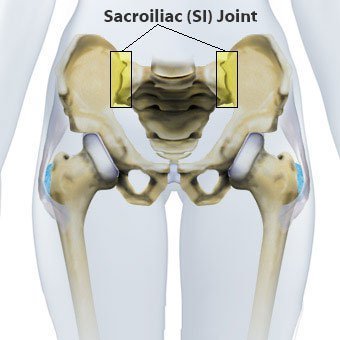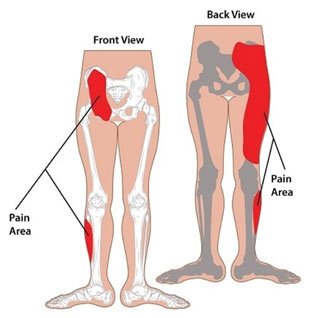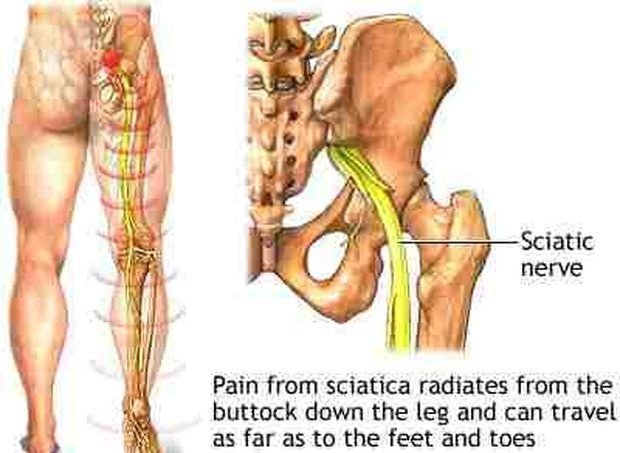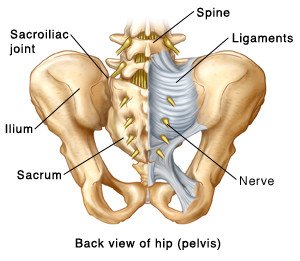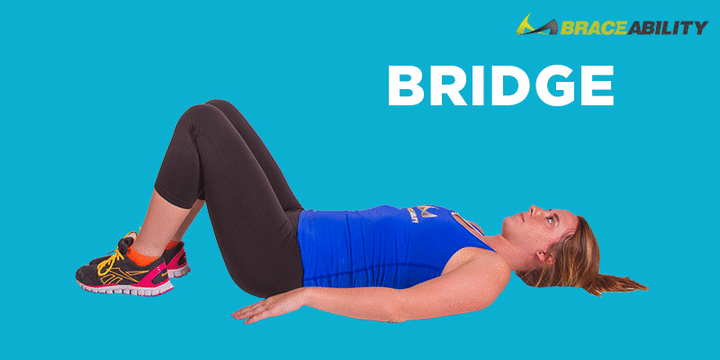
SI JOINT PAIN
What are the SI Joints?
The SI Joints, or sacroiliac joints, are responsible for keeping the pelvis and the sacrum attached to each other. These joints are found at the base of the spine, with one at each side. This is a strong joint and helps to transmit the stress from the upper region of the body toward the pelvis area, as well as the legs.
Pain from SI Joint Sprains
When the SI joints are sprained, the pain that patients typically describe is sharpness along the dimples near the bottom of your spine, one on each side. This can also be accompanied by a band of tightness and a dull ache across the lower back as the surrounding muscles begin to tighten up to protect your back.
One particular problem with SI joint dysfunction and sprains is that they are often accompanied with referred pain. What this means is that you may feel pain elsewhere down your leg or across your low back in areas that are not close to your SI joints. Thus it makes it hard to self-diagnose SI joint sprains/dysfunction at home because a physical examination is required to confirm the exact cause of your pain.
Patients are generally advised to be wary of pain in the following areas of their body:
Spine
Lower back
Pelvis
Groin
Buttocks
Legs
Muscle pain from SI joint injuries can also happen due to guarding in the surrounding muscles. This is a common occurrence with SI injuries because the body is simply trying to protect these joints. Unfortunately, this muscle guarding will ultimately lead to muscle pain across the lower back and even into your legs.
Other symptoms that patients should look out for which may indicate a problem with their sacroiliac joints, include:
Numbness or weakness in the lower extremities
Tingling sensation in the lower extremities
Instability in legs
Pain that causes a disruption in sleep
Pain when standing up from a seated position
Pain while sitting, or hard finding a comfortable sitting position
How Long Does SI Joint Pain Last?
After you have sprained your SI joints, it may take some time to recover. Patients are often worried whether the SI joints will heal or if it’s a permanent injury…and the good news is yes it usually makes a full recovery! These are not permanent injuries fortunately but recovery time can vary from weeks to months.
How quickly you’ll recover from a SI sprain will depend on a number of factors. One of the most important factors is how you hurt your SI joints to begin with, and also the severity of the injury. A fall or some type of trauma will likely lead to a more severe injury and thus a longer recovery time. Further, if the injury has been ongoing for some time without proper care or is a recurring injury, this will likely prolong your recovery.
A strain in the sacroiliac joints from a fall or from sitting too long is usually an acute injury, and typically not as severe. The recovery time from a SI sprain in this case is usually shorter, around 1-2 weeks. With appropriate treatment and rest, patients can expect an even faster recovery time.
In some cases, an acute injury may take a few weeks to heal if there is some trauma, or if the spine is not in a good condition (lack of exercise, sedentary lifestyle, desk job, etc). In this case, the SI joints will require a longer recovery time. In some unfortunate cases, the pain can even become chronic, which means the pain symptoms will continue to linger even after 3 months.
Can SI Joint Dysfunction cause Knee Pain?
With SI joint injuries, knee pain is often an accompanying symptom. But how does this work?
When dysfunction occurs with the sacroiliac joints, complications can then arise in other areas, particularly the hips, knees, and ankles.
Because the SI joint is a weight-bearing joint, it can be painful to pressure on it if the joint is injured. As a result, we start to compensate and change the way we move so that we put less pressure on the SI joint. This can typically lead to biomechanical changes (poor alignment) in the knees, such as:
A tilt in the knee can develop, leading to either outward or inward femoral rotation
Genu varus (bowlegs) or genu valgus (knock-knees)
Consequently, we start to change the way to walk, the way we stand up from a chair, or even the way we go up and down stairs. Simply put, our bodies will naturally want to avoid the SI joint pain and this leads to poor biomechanics within the knees.
These knee symptoms will also become more severe over time if the initial SI injury is not properly addressed.
Can SI Joint Dysfunction cause Sciatica?
Firstly, sciatica merely describes pain down the back of the legs. People are often worried that sciatica is directly a result of pinching the sciatic nerve. However, impingement of the sciatic nerve is actually quite uncommon and sciatica (pain in the back of the legs) is usually NOT a result of impingement on the sciatic nerve.
In the case of SI joint dysfunction, it can sometimes lead to sciatica due to irritation of superficial nerves. This is a chemical reaction to joint injury and not a true nerve impingement.
SI joint sprains can also cause sciatica as a result of referred pain from muscle guarding. Muscle spasms in SI joint injuries are quite common because the body is naturally trying to protect the joints. As a result, you have overactive low back muscles which consequently produces some sciatic pain.
Fortunately sciatica from referred muscle pain is easy to manage with appropriate treatment and by no means permanent.
Common Causes of SI Joint Pain And Dysfunction
While the sacroiliac joints are strong and considered to be sturdy, there are times where dysfunction can develop. Traumatic injury is a common issue that occurs, which may lead to complications like SI joint ligament sprain pain.
It is important to recognize SI joint injury symptoms and to act as soon as possible. Appropriate treatment can help reduce the severity of the pain that the patient is experiencing, while accelerating recovery time.
Sacroiliac joint pain symptoms often occur due to the presence of an underlying issue. It is also important to understand that there are certain risk factors that increase your likeliness of injury.
First, it should be noted that there are cases where SI joint pain symptoms tend to develop quickly. This is usually the case with a SI joint injury from a fall. This would be considered an acute injury, which leads to the rapid onset of the symptoms that we have previously described. In other cases, however, such as the development of SI joint dysfunction, the symptoms may occur more gradually.
SI joint ligament damage is the most common injury to the SI joints. It can occur in cases of pregnancy, as well as following childbirth. Certain activities, such as heavy lifting and jobs that are labour-intensive, may also lead to repetitive strain on the ligaments in the area, which means there are additional risk factors to be noted.
SI joint separation can occur in cases of significant trauma, which is a possibility in contact sports or motor vehicle accidents. The pain is typically rapid in onset and can be extremely severe.
Lastly, SI joint fusion can occur in ankylosing spondylitis, a progressive disease that has also been associated with SI joint pain. Ankylosing spondylitis is a type of arthritis and the condition is progressive, which means the symptoms typically develop gradually over time, instead of a sudden onset.
SI Joint Pain and Injury from Sport & Exercise
A significant number of injuries to the sacroiliac joints in the general population are caused by sports, as well as certain types of exercises. This is due to the stress that certain activities can put on the upper body, which is then distributed downward to the sacroiliac joints.
Weight lifting and strength training exercises, such as deadlifts and squats, are known to cause repetitive strain on the SI joints. SI pain after weight lifting is usually related to ligament sprains but can also be coupled with other injuries such as lumbar disc herniations, facet sprains, or lumbar nerve impingements.
In the example of a squat, the SI joint can become injured at the bottom of a squat, when the pelvis drops further than it should. This is usually a result of poor mobility.
Deadlifts on the other hand, can result in a SI injury if the pelvis does not begin in a tucked position when initiating the lift. The SI joints can also become sprained if you curl your lower back too much during the lift. It is ideal to maintain a straight back if possible at all times during the lift.
Running is another common exercise people may experience some SI pain. Poor extension in the hips can often lead to overloading the SI joints and can cause a recurrent SI joint injury. If the sacroiliac joints are already injured, running may further exacerbate your injury as the impact of running can irritate the joints.
SI Joint Pain During and After Pregnancy
During pregnancy, a woman’s body goes through a number of changes. As hormone alternations occur, the body prepares for the delivery of the baby. There are certain changes to the SI joints during pregnancy. As part of this process, the sacroiliac joints become more elastic, which helps the pelvis expand since the baby needs to move through this area during delivery.
The increase in elasticity of the sacroiliac joint ligaments leads to instability of the joints themselves. There is also an increase in the joint motion, which is an issue because these joints are not designed to move too much. The result: pain! Fortunately, there are numerous techniques we use in clinic to help stabilise these joints.
Patients are often also concerned about whether their SI joint pain will go away after pregnancy. The good news is that the pain and discomfort do improve after giving birth in most cases. However, the recovery time can vary dramatically from weeks to months.
Your recovery time post-pregnancy will be affected by a few factors such as the condition of your back leading up to pregnancy, whether you had a C-section, or how active you are.
If you are concerned of SI joint pain with pregnancy, we often recommend you have your back assessed as early on as possible and begin a core strengthening routine for the best possible outcome. This can be done safely even during pregnancy.
Treatment
Having a correct diagnosis early on is vital if you want to avoid any potentially serious complications further down the track. Early treatment typically leads to a more positive and successful outcome.
When a patient presents with symptoms that could indicate a problem with the sacroiliac joints, a full assessment and evaluation of the sacroiliac joints and lumbar spine is required.
As a sports chiropractor, our first task is to conduct a physical examination to determine the cause of your pain, and if further information is required, we may refer for a series of images such as X-rays. In more severe cases, a MRI of the pelvic region may be required.
Once we can confirm a diagnosis for your pain, a treatment plan is developed to provide the patient with SI joint relief protocols. The specific treatment that will be provided will depend on the diagnosis, as well as the severity of the injury.
The first step in treatment is to help relieve pain and also protect the joint from additional injury or damage.
Protection of the sacroiliac joints can also be achieved with a SIJ stability belt, which helps keep the sacroiliac joints more stable. This can be particularly beneficial in the early stages of recovery but not a good long-term solution.
Once the joints have settled down, the next step is to provide strengthen and rehabilitation. This includes restoring normal range of motion in the area, as well as to strengthen the muscles that support the joint.
At this stage, chiropractic treatment is often recommended to accelerate the recovery process. Spinal manipulations restore movement to the sacroiliac joints. This is coupled with rehabilitative exercises to strengthen the muscles around the joints.
However, in more severe cases, this is not where treatment ends. The duration of treatment can be extensive if the patient has suffered a traumatic injury, or repetitive injuries to their sacroiliac joints. In this scenario, additional care is required as the risk of reinjury is quite high.
At-Home Treatment Options
If you’re suffering from SI joint pain and need some relief at home, here’s some things to try.
A SI joint stabilisation belt is a great tool in the initial stages of the injury. This type of belt is placed around the pelvic area and can help stabilise the sacroiliac joints. This takes pressure off the joints (thus reducing pain) and also supports the joints so they can heal faster.
Although this belt can protect the SI joints in the initial stages of an injury, it is important to note that this is not a good long-term solution as this may weaken your core muscles as you begin to rely on the belt. This ultimately results in more recurring injuries!
To see what a SIJ stabilisation belt looks like, follow this link.
Read more about SI Joint Pain…
What else can you do for SI joint pain at home?
Another two great options that can be utilised at home would be hot and cold therapy.
You can use cold therapy, such as an ice pack wrapped in a towel, applied directly to the areas where symptoms are experienced, to reduce the level of pain.
Heat can be applied to the area to help reduce inflammation and improve blood circulation, which can help to promote the healing process.
And lastly, the best sleeping position for SI joint pain is on your side. Make sure you tuck a pillow between your knees to create a cushioning effect and this will also provide support for the sacroiliac joints.
You should also see our section below on the Best Exercises for a SI Joint Injury!
SI Joint Injury Exercises
Even though certain physical activities can actually increase the risk of an injury to the sacroiliac joints, it is important not to keep still for too long while recovering from this injury.
In fact, there are certain exercises that are beneficial for SI joint injuries, and can help improve the strength of muscles and ligaments in the area, thus speeding up the recovery process.
Here’s a simple SI joint mobilization exercise: while laying down on your back, bend both knees and slowly pull both knees towards your chest. This is a great exercise because it does not cause significant strain on the muscles in the pelvic area but still provides a good stretch to help with mobilising the sacroiliac joints.
Here’s a list of other great exercises you can try to help relieve sacroiliac joint pain (see below for photos):
Knee rotation
Bridge
Cobra pose (yoga)
Child’s pose (yoga)
Bird dog (yoga)
And of course, there are certainly SI joint exercises that you should AVOID if you are injured. This includes:
Golf
Weightlifting
Biking
Football
Sit-ups
Crunches
Surgery
When conventional treatment methods have not yielded a significant improvement in symptoms or the injury is too severe, a specialist may advise a patient that a surgical solution could be the best option for their recovery.
Surgery options for SI joint injuries depend on a few factors, but a sacroiliac joint fusion is often the preferred procedure.
During this procedure, the sacrum and ilium are grafted together. The idea behind these procedures is to provide a further limitation in the motion of the two joints.
SI joint fusion recovery time has improved significantly over the years, as many of these procedures are now considered minimally invasive.
Patients should still understand what to expect after SI joint fusion, as there will be a period where the patient needs to remain in hospital for a few days. There will also be a recovery and follow-up rehabilitative process that can last up to six months.

